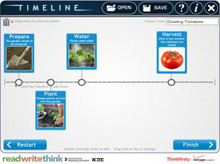 In my December post (Language Arts Apps Save the Day), I wrote about the incredible apps being produced by the team at ReadWriteThink.org. I cannot say enough good things about these apps—they are a staple in my classroom and have allowed my language arts classes to become interactive and paperless to an extent that I was unable to achieve before discovering these amazing tools.
In my December post (Language Arts Apps Save the Day), I wrote about the incredible apps being produced by the team at ReadWriteThink.org. I cannot say enough good things about these apps—they are a staple in my classroom and have allowed my language arts classes to become interactive and paperless to an extent that I was unable to achieve before discovering these amazing tools.
Recently, my personal favorite of the RWT app collection, RWT Timeline, has been recognized as a 2014 Best App for Teaching and Learning by the American Association of School Librarians, which is part of the American Library Association. This is a well-deserved honor for an organization that has done so much to finally bring language arts instruction for the intermediate and middle school grades into the digital age. Although I have written an overview of all the RWT apps in the past, this award is an opportunity to put the spotlight solely on RWT Timeline.
As a sixth grade teacher in Illinois, teaching students how to read and use timelines was explicitly required under the Illinois Learning Standards. In the first few years of my career, I taught this skill because it was a required part of our curriculum. As time passes, though, and the age of Common Core descends, I continue to teach this skill for its value to my students.
I work with a high percentage of students who are reading below grade level, as well as a fair amount with special needs. I was completely flummoxed the first time I realized I had students—quite a few students, in fact—who were unable to sequence a simple story. As my students and I have made the journey from strict curriculum to project- and inquiry-based learning, from paper and pencil to digital tools, from reading textbooks to researching online, I have seen the varied ways in which timelines can be applied, for both simple and complex tasks.
We use timelines to highlight important events in a historical time period, such as the Civil Rights Movement. This helps my students not only learn the history, but to discern between major and minor details. We create timelines for the lives of people we study, such as Robert Ballard, and events we want to understand better, such as the sinking and discovery of the Titanic. We create and use timelines to plan our research and presentation projects, so every person in my classroom has to think about the processes and tasks involved in accomplishing their goals and set their own reasonable deadlines, an important skill my sixth graders have had few prior opportunities to develop. We use timelines to lay out the events of a story, both to facilitate comprehension and practice a skill that is lacking for some, as well as dissecting plot development and author's craft.
I'll be honest—pre-iPad timelines weren't always my favorite thing. They took up a lot of space, ended up a scribbled mess due to the inevitable errors along the way, and if we used pictures or pre-printed events, they were a sticky mess. Contrary to popular opinion, most sixth graders aren't much better with glue than kindergarteners. But this is the beauty of RWT Timeline. My students create their timelines on their iPads, reducing the clutter. They can save and edit, allowing for the timelines to be an ongoing project—as they should be. The app is simple enough in design to be very easy to use, but functionally complex enough to be appropriate for intermediate and middle grades. There are no hidden catches or "in-app purchases," students can create any number of timelines with as many entries as they need. Students can add pictures to their entries which, according to my kids, is always the best part of the project. And my favorite part, finished timelines can be emailed—even if an email account is not set up on the iPad. The app itself has email capability and sends the finished product to me for evaluation or printing. Multiple projects can be saved to the app, so more than one student can use the same iPad to work on their own projects, without having to delete other in-progress pieces of work.
I am so impressed with the RWT Timeline app and all the possibilities it opens within my classroom. It is thrilling to see an organization recognized for producing quality language arts apps, which is still one of the areas of greatest need in the classroom. Take the time to download and try these apps and give them your support. Use them, talk about them, and share them on social media, so we can continue to see language arts treated as an important focus for digital instruction design.
 Lindsey Fuller is a sixth grade teacher in Decatur, Illinois. Her interests are classroom technology integration, literacy instruction, and Common Core curriculum development and implementation. You can read more from Lindsey on these topics at her blog, Tales of a 6th Grade Classroom and follow her on Twitter at @linlin8.
Lindsey Fuller is a sixth grade teacher in Decatur, Illinois. Her interests are classroom technology integration, literacy instruction, and Common Core curriculum development and implementation. You can read more from Lindsey on these topics at her blog, Tales of a 6th Grade Classroom and follow her on Twitter at @linlin8.